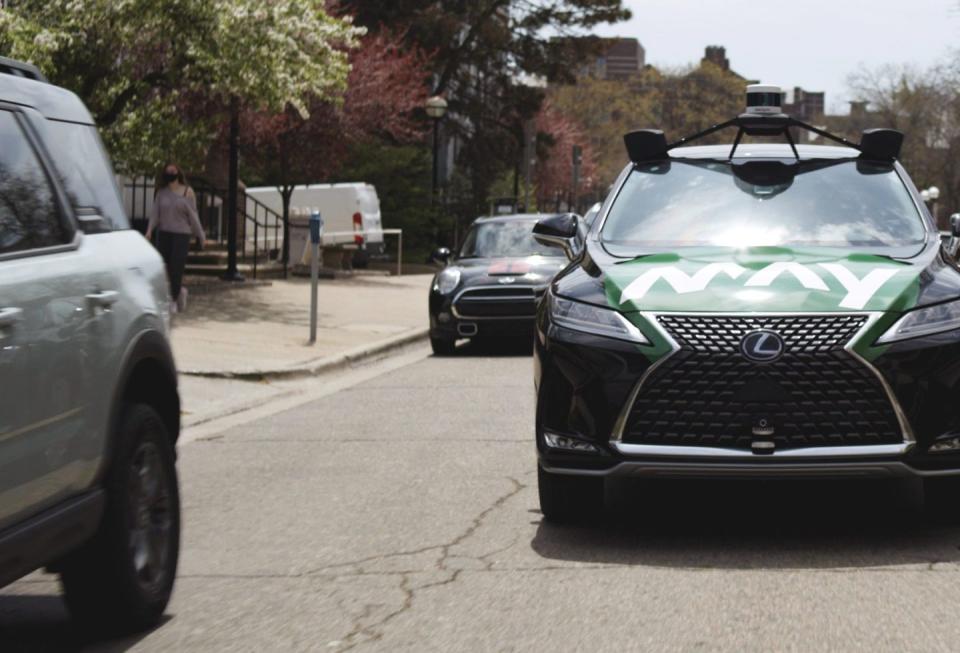Don’t Give Up the Steering Wheel Just Yet, Experts Say

In 2019, electric vehicles and autonomous vehicles appeared to be on the same trajectory toward adaptation and consumer acceptance. Today, AVs have fallen way behind.
The managing director of the University of Michigan’s MCity research facility says exuberance for autonomous vehicles “is waning a bit.”
A recent survey found “65% of consumers possess inaccurate knowledge of the definition for fully automated self-driving vehicles.”
Elon Musk “teased” development of a dedicated robotaxi, sans steering wheel and pedals last April at Tesla’s “Cyber Rodeo,” the grand opening extravaganza for the EV-maker’s Gigafactory near Austin, Texas. Musk promised it would be “quite futuristic-looking.”
Musk “discovered” full autonomy around the middle of the last decade and said Tesla would have it in a year, even though “legacy” automakers had competed in DARPA’s autonomous-vehicle challenges a full decade earlier and had yet to put SAE Level 2 assisted driving on the street.
“I feel confident predicting autonomous robotaxis for Tesla next year,” Musk said at the company’s Autonomy Day in April 2019. By then, electric vehicles and autonomous vehicles—including those from “legacy” automakers—appeared to be on the same trajectory toward adaptation and consumer acceptance for roughly 2025-30.
Currently, EVs are on their way to that goal. AVs are not.
“Indeed, 2022 was the year of EVs,” says Michelle Krebs, executive analyst for Cox Automotive. “While the rest of the US market was down, EV sales look like they will come in at 60% to 70% higher than last year—about 800,000 sales. We expect EV sales will keep rising in 2023.”
Krebs says autonomous vehicles “were always the bigger challenge. Technical challenges remain daunting. Some AV developers note the greatest progress has been made, but that last 10% is the hardest. AVs have not been helped by Tesla’s Autopilot incidents and investigations.”
When Argo AI—which was backed largely by Ford Motor Company and Volkswagen Group—folded in October, CEO Jim Farley said Ford would pull back from developing Level 4 and concentrate on “Level 2-plus” and Level 3 in-house.

“We still believe in Level 4 technology, that it will have important impact in moving people,” Farley said. But he also noted the industry had invested some $100 billion in Level 4 technology without fully identifying its value for consumers.
“We’ve definitely seen a shift,” says Greg McGuire, managing director of the University of Michigan’s MCity research facility, which is used for testing autonomous vehicles. “I think the exuberance is waning a bit.”
Testing at MCity is back up to normal after the pandemic, with a recent shift toward other electronics and safety systems. “We’ve always said there are key scientific barriers that remain unsolved—the challenges haven’t gone away,” McGuire says. “Machines don’t even approach the capabilities of humans.”
Sam Fiorani, vice president for global vehicle forecasting at AutoForecast Solutions, says timelines established by autonomous vehicle advocates have always been optimistic.
“From pedestrians to same-direction traffic to oncoming traffic to snow and rain, there are just so many unknowns that must be anticipated by a computer before we can trust Level 4 or Level 5,” Fiorani says. “While modern vehicles have raised the level of autonomy to SAE Level 2 and Level 3, making that last giant leap to Level 5 is still years away.”
General Motors was more upbeat about full self-driving at its Investor Day presentation to Wall Street analysts in November, where CEO Mary Barra said the company expects $1 billion in annual revenues from its Cruise AV subsidiary by 2025. GM announced a year earlier, at its 2021 Investor Day, it expects to have 1 million autonomous vehicles on the road by 2030, and last September announced expansion of its Cruise pilot program in San Francisco to add Austin, Texas (Tesla’s new backyard, coincidentally), and Phoenix.
Despite its progress, NHTSA has announced an investigation into Cruise vehicles for “inadvertent hard-braking” and other development growing pains that the federal agency will examine in detail.
“Though Ford made the decision to shift focus and funding, VW’s global AV programs continue forward,” says Stephanie Brinley, associate director for AutoIntelligence at S&P Global Mobility. “GM, Waymo, and Motional are making progress, with GM already charging for [robotaxi] rides in California.”
In Las Vegas, Uber with AV developer Motional has launched a pilot program to test Hyundai Ioniq 5 EV robotaxis, though with “safety drivers” at the wheel.

What are SAE Levels 2, 3, 4, etc? The average consumer doesn’t know nor care. JD Power’s 2022 US Mobility Confidence Study reports that “56% of respondents classify driver-assistant technologies that are available today as being fully self-automated, self-driving technologies, when, in fact, drivers are still expected to be actively involved in the driving task.”
The study, conducted with Partners for Advanced Vehicle Education and Massachusetts Institute of Technology’s Advanced Vehicle Technology Consortium, surveyed consumers who purchased vehicles within the last 10 years, and found “65% of consumers possess inaccurate knowledge of the definition for fully automated self-driving vehicles.”
Level 2 or Level 3 may be enough for most drivers, according to the JD Power study. Most of the consumers surveyed consider full self-driving tech best for public transportation, says Lisa Boor, JD Power’s senior manager for auto benchmarking and mobility development.
“It’s a great thing and we see value in it—for other people,” Boor says. The study says 41% of respondents chose “driver assist,” described as features that actively help the driver while the driver remains in control, as the level they want in their personal vehicles. Just 12% of the JD Power respondents prefer full self-driving, and “emergency-only” driver-assist, at 15%, edged out partial self-driving, at 14%.
“Autonomous vehicles are still on automakers’ radar,” says Ed Kim, president and chief analyst for AutoPacific. “But the relative lack of consumer and regulatory demand means that AV development has taken something of a back seat for most manufacturers. It’s no surprise though that GM is still powering through on AV development, as they were the first to offer any sort of hands-free driving with SuperCruise in 2017.”
Do you think the future of autonomous vehicles can overcome current technological hurdles and ongoing federal safety investigations? Please comment below.

 Yahoo Autos
Yahoo Autos 